Between sacred and profane
Supper at Emmaus and biblical feasts
Biblical feasts were one of the major themes of the latter half of the sixteenth century. Titian, Tintoretto, Veronese, and indeed Bassano have all provided monumental examples of this. The celebration of the supper at Emmaus echoes the Last Supper. It was the moment, as recounted by Luke, when the two pilgrims Christ was traveling with recognized him as he consecrated the bread and the wine. “Then their eyes were opened and they knew Him.”
Titian produced many versions of this theme for the commissioning patrons of his generation. The painting in the Musée du Louvre reflects a careful reading of Leonardo da Vinci’s Last Supper—a long, horizontal table, a frontal view of Jesus against the backdrop of a landscape punctuated with vertical architectural elements, the posture of one of the pilgrims reminiscent of that of Leonardo’s Judas. Titian chose to portray the moment when both pilgrims realize the identity of the figure they encountered. It also provided him with an opportunity to painstakingly reconstruct the white tablecloth with its many folds and creases, the oriental carpet, and the items on the table (saltcellar, decanter, glasses, bread).
Tintoretto took up the theme of Supper at Emmaus very early on. One early version suggested that he was looking to challenge his elder but that his ability did not yet live up to his ambitions. However, a few years later in the Last Supper he produced a brilliant take on his previous attempt in the consummate skill of his eloquent poses, the focus on simplicity and everyday life, the pronounced chiaroscuro, and the vibrant energy.
Veronese’s Supper at Emmaus, now in the Louvre’s collections, offers a quite different register. It would appear to be the first of a large series of biblical feasts marked by a mixture of sacred narration and portraits of the Venetian aristocracy, even if the result here lacks complete mastery of style. Unlike Titian and Tintoretto, Veronese chose to depict the moment of Christ’s blessing of the bread; the composition is evocative of Raphael’s Transfiguration in its sense of balance and harmony.
 Learn more+
Titian
, Supper at Emmaus
Learn more+
Titian
, Supper at Emmaus
Paris, Musée du Louvre
(Inv 746)
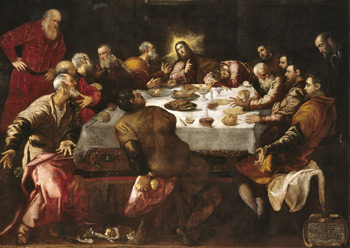 Learn more+
Tintoretto
, The Last Supper
Learn more+
Tintoretto
, The Last Supper
Paris, church of Saint Francis-Xavier
(Inv FXA42/299)
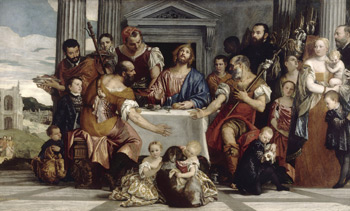 Learn more+
Veronese
, Supper at Emmaus
Learn more+
Veronese
, Supper at Emmaus
Paris, Musée du Louvre
(Inv 146)
Close x
Titian, Supper at Emmaus
Paris, Musée du Louvre
(Inv 746)
This work is a masterful demonstration of Titian's talent in terms of structure, color, the anatomy of the figures and their movements, landscape, and still life. In the disciple to the right we can recognize the figure of art patron Nicola Maffei, chief minister to Federico II Gonzaga of Mantua.
© RMN / R. G. Ojéda

Click on the picture to zoom: Supper at Emmaus (new window)
Close x
Tintoretto, The Last Supper
Paris, church of Saint Francis-Xavier
(Inv FXA42/299)
Tintoretto's focus here is on simplicity and everyday life in a pronounced chiaroscuro of vibrant energy; the scene takes place in a humble room in an inn where the apostles with their coarse homespun and patched garments are gathered in a more convivial manner around a square table rather than behind a long one, adopting very eloquent postures.
© COARC / Roger-Viollet

Click on the picture to zoom: The Last Supper (new window)
Close x
Veronese, Supper at Emmaus
Paris, Musée du Louvre
(Inv 146)
This is one of the first paintings in the incredible series of great biblical banquet scenes. Veronese has chosen to depict the moment when Christ blesses the bread, surrounded by a group portrait of the aristocratic family who commissioned the picture.
© RMN / Gérard Blot

Click on the picture to zoom: Supper at Emmaus (new window)
Between sacred and profane
Portraits of family and children
During the Renaissance, having one’s children’s portrait painted was seen as a means of protection against the quirks of fate. Children would adopt their parents’ conduct, attire, and ornamentation as a mark of continuing virtue and elegance, even if they were depicted with an innocence and expressiveness befitting their tender age.
While children are rare in Tintoretto’s work, perceived rather as spectators in religious narrative paintings, Titian and Veronese produced many portraits in which aristocratic status is tinged with humor and spontaneity. This is also true of their religious painting in which they did not hesitate to use children to counterbalance a scene’s solemnity, delighting in portrayals of their boisterous energy and affection.
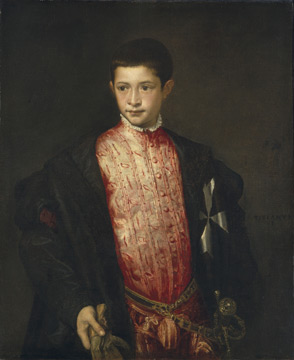 Learn more+
Titian
, Ranuccio Farnese
Learn more+
Titian
, Ranuccio Farnese
Washington, National Gallery
(Inv 1952.2.11)
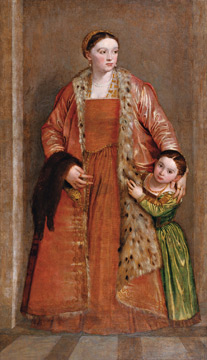 Learn more+
Veronese
, Livia da Porto Thiene and Her Daughter Porzia
Learn more+
Veronese
, Livia da Porto Thiene and Her Daughter Porzia
Baltimore, The Walters Art Museum
(Inv 37-541)
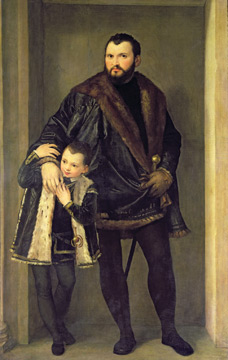 Learn more+
Veronese
, Iseppo da Porto and His Son Adriano
Learn more+
Veronese
, Iseppo da Porto and His Son Adriano
Florence, Donazione Contini Bonacossi
(Inv CB16)
Close x
Titian, Ranuccio Farnese
Washington, National Gallery
(Inv 1952.2.11)
The twelve-year-old boy is wearing a cloak too big for him emblazoned with the insignia of the Knights of Malta, in reference to the fact that he was prior of the knights' property in Venice. While the bearing and costume are similar to those in Titian's portraits of adults, the alert face and impetuous expression are indeed those of a young boy.
© Board of Trustees of the National Gallery, Washington

Click on the picture to zoom: Ranuccio Farnese (new window)
Close x
Veronese, Livia da Porto Thiene and Her Daughter Porzia
Baltimore, The Walters Art Museum
(Inv 37-541)
Venice was a great center for family portraits in the sixteenth century. Veronese has succeeded in capturing the spontaneity of youthful vigor. The young girl, partially obscured by her protective mother, appears to loom up to stare at the viewer with her wide innocent eyes. The artist has carefully rendered the silken fabrics and fur.
© The Walters Art Museum Baltimore

Click on the picture to zoom: Livia da Porto Thiene and Her Daughter Porzia (new window)
Close x
Veronese, Iseppo da Porto and His Son Adriano
Florence, Donazione Contini Bonacossi
(Inv CB16)
In this portrait of Iseppo da Porto and his son Adriano, the companion piece to the portrait of Livia and her daughter, Veronese lingers over the father-son relationship. The young boy is playing with his father's ungloved hand placed protectively on him as he watches his sister on the other side of the window between them. The relationship between the parents and children is highly moving.
© Galerie des Offices / Bridgeman Art Library

Click on the picture to zoom: Iseppo da Porto and His Son Adriano (new window)
Between sacred and profane
Paintings of dogs
Around the mid-sixteenth century Venice saw the first portraits of dogs as protagonists rather than secondary players. The inventor of this type of portrait was probably Jacopo Bassano with his Two Hunting Dogs Tied to a Tree Stump, dating from 1548-49. From the late 1530s onward, animals—dogs in particular—would play a particularly important role in his representations of sacred scenes. Bassano saw them not only as symbols of faithfulness and purity, but he would tend to produce lifelike portraits, attentive to such details as their morphology and the rendering of their fur.
This type of representation was to fascinate Venetian artists already highly tuned to the painstaking study of nature. Titian—and Veronese to a lesser degree—would endeavor to depict an animal’s anatomy and fur, as well as their expressions, with great care and attention.
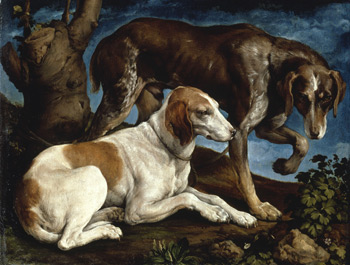 Learn more+
Jacopo Bassano
, Two Hunting Dogs Tied to a Tree Stump
Learn more+
Jacopo Bassano
, Two Hunting Dogs Tied to a Tree Stump
Paris, Musée du Louvre
(RF 1994-23)
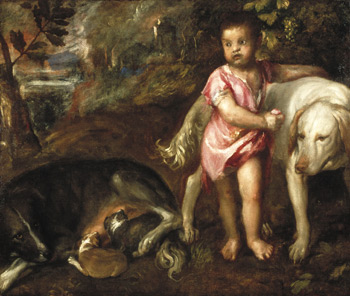 Learn more+
Titian
, Boy with Dogs in a Landscape
Learn more+
Titian
, Boy with Dogs in a Landscape
Rotterdam, Museum Bojmans Van Beuningen
(Inv 2569)
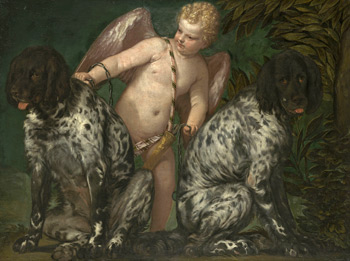 Learn more+
Veronese
, Cupid with Two Dogs
Learn more+
Veronese
, Cupid with Two Dogs
Munich, Alte Pinakothek
(Inv n°29)
Close x
Jacopo Bassano, Two Hunting Dogs Tied to a Tree Stump
Paris, Musée du Louvre
(RF 1994-23)
Produced in 1548 for the Venetian patrician Count Zantani, this work is the first animal portrait in Western painting. In a constrained framing typical of mannerism and a composition formed entirely of curves and counter-curves, the artist depicts his own dogs—two pointers—in a completely natural setting. He would often include them in his sacred works of the mid-sixteenth century.
© RMN / Daniel Arnaudet

Click on the picture to zoom: Two Hunting Dogs Tied to a Tree Stump (new window)
Close x
Titian, Boy with Dogs in a Landscape
Rotterdam, Museum Bojmans Van Beuningen
(Inv 2569)
Titian always demonstrated great attentiveness to animals in his works and a real genius for depicting their anatomy, their fur, their actions, and their expressions. On the left the bitch is suckling her two pups while the boy seems to be holding his balance by leaning on the standing dog.
© Museum Boijmans Van Beuningen, Rotterdam

Click on the picture to zoom: Boy with Dogs in a Landscape (new window)
Close x
Veronese, Cupid with Two Dogs
Munich, Alte Pinakothek
(Inv n°29)
Throughout his career, Veronese showed a very pronounced taste for dogs, which always enlivened his history paintings. Yet, contrary to Bassano or Titian, he would depict the animals with less anatomical precision, preferring lines and graceful, slender forms with a highly decorative hint of geometrical abstraction.
© BPK, Dist RMN/BStGs

Click on the picture to zoom: Cupid with Two Dogs (new window)



















